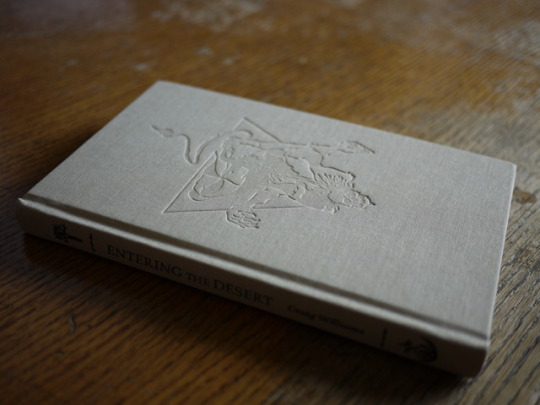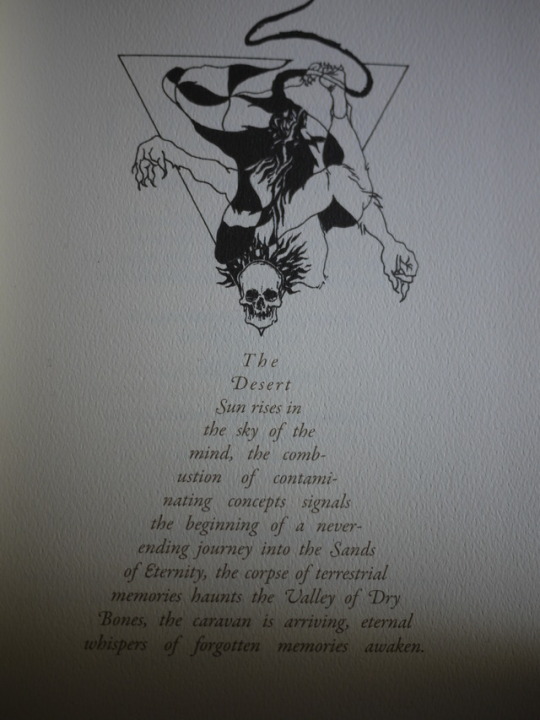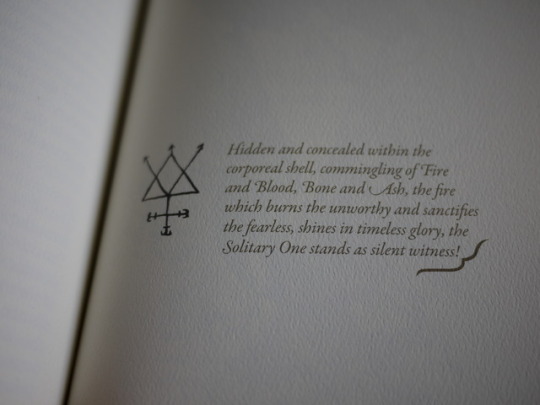#Anathema Publishing Ltd.
Explore tagged Tumblr posts
Text
pg 36* = "Anathema had learned to read from The Book. It didn't have any apples and balls in it. It did have a rather good eighteenth-century woodcut of Agnes Nutter being burned at the stake and looking rather cheerful about it."
pg 52 = "It was published by Bilton and Scaggs in September 1655"
What's an 18th century woodcut doing in a mid 17th century book?
Has anyone asked @neil-gaiman about this?
*page numbers refer to the 2013 Victor Gollancz Ltd edition
#good omens the nice and accurate prophecies of agnes nutter witch#good omens#neil gaiman#terry pratchett#gnu terry pratchett#question from yours truly#agnes's book#another excuse to go looking through 18th century prints in the online collections of the british museum? don't mind if I do!
16 notes
·
View notes
Text
G. McCaughry, editor. Pillars: Seeds of Aries (Vol.2, Issue.2). Montreal: Anathema Publishing, Ltd., 2020. Standard hardcover edition. 192 pages. Limited to 618 Copies (#47/618).
Shop link in bio.
instagram
2 notes
·
View notes
Text










Come rest by the hearth’s fire and warm yourself, now that your travels are at an end.
The night is long, and we are in no hurry. This is a time for reflection, to think back on where you have been – and where it has led you to.
Whether you have crossed oceans or deserts, wound your way through labyrinthine cities or long-forgotten ghost towns, followed untrodden paths or the pilgrim’s well-worn way – you are no longer the same, and you have wisdom to share.
Pillars: A Wayfarer's Hearth (Volume 2, Issue 3).
Anathema Publishing Ltd.
0 notes
Text









SEMESILAM: The Eternal Sun
Preface by Frater Acher Prologue for Semesilam, by José Gabriel Alegría Sabogal
Book I. A Handbook of Sacred Anatomy A Note from the Author to the ReaderA Handbook of Sacred AnatomyIndex of Images (for Book I)
Book II. A Second Nature Introduction: The Two NaturesThe Power of Books, the Power of Images, and a Book of ImagesAngels or Manifestations: The BeheldMetamorphosesDeath & ImaginationSymbolsBone WorksA Second NatureIndex of Images (for Book II )
AcknowledgementsVerses
Epilogue: Portæ Lucis — Solarization of the Crypt, by G. McCaughry
In the new prologue to Semesilam, Sabogal offers personal insight into the diverse circumstances that played a role in producing this corpus, including the motifs, symbols, and ideas behind them, and further interpretations of various images and themes – Gnostic Symbolism, Angelic Iconography, and Symbols of the Unconscious among others – which have been crucial to his artistic process.
Within this myriad of symbology and meaning, the Sun is at the forefront, a recurring symbol and inspiration for the book’s title, Semesilam – here identified as an inscription often found on the so-called Abrasax Gnostic gemstones, pointing to the everlasting nature of the solar orb.
The material from Handbook of Sacred Anatomy constitutes a Mutus Liber that explores mystical interpretations of human remains, while A Second Nature was significantly inspired by Jungian analyses, delving also into the mysterious Akephalos, the headless figure – symbolically suggestive of both the dragon and contemplation of death – used by surrealist author Georges Bataille, who, in an uncompromising non-rational way, sought to create its own visual associative language.
A new preface by Frater Acher (author of the Holy Daimon trilogy [Scarlet Imprint, 2018; 2020; 2022], Clavis Goêtica [Hadean Press, 2021], and Ingenium [Tadehent Books, 2022]), and an epilogue by Gabriel McCaughry (founder and owner of Anathema Publishing Ltd., and author of (h)Aurorae, [Anathema Publishing, 2018] also illustrated by José), both give testimony to Sabogal’s long-standing personal, literary, and artistic relationships – the fruits of which have taken the form of several publications and have inspired the artwork compiled here.
Semesilam features a new and carefully designed layout by artist and typographer Joseph Uccello, which enhances the presentation of this collection, thereby making it available as a fine edition, showcasing material that has been otherwise out of print for a considerable while. Certainly, a worthy addition for those who are interested in José Gabriel’s body of work.
0 notes
Photo

Hortus Aureus, 2017
Acrylics and gilding on paper, 34,8 x 28 cm
6K notes
·
View notes
Photo

The Devil’s Supper, by Shani Oates
The story of the Devil has been told by many over the years — by those who think they know him and by those who wish they did. The Devil’s Supper begins by inviting the reader to listen to his tale and drink from his cup.
Shani Oates gives a history of primal deities, how in recent times they have been viewed as evil, but that it was not always the case. As an example, she talks about Set and how his actions against Osiris was out of necessity with no intention of evil. Many gods had both negative and positive forces within them and were not seen as intrinsically evil or good. There was no duality as in Christianity. To create and destroy, all things were deemed necessary.
[Read the full review.]
2 notes
·
View notes
Text









José Gabriel Alegría Sabogal was Born in Berlin, and currently lives and works in Lima, Perú. He studied painting at PUCP (Pontifical Catholic University of Perú) and the Universitat de Barcelona (UB). Currently, José is completing his Masters in the History of Art at PUCP.
His visual work makes use of the line-technique found in renaissance copper plate engraving, but now applied to drawing. Both the themes and their treatment José explores are essentially anachronistic, and follow the initiative of developing a symbolic language that aspires to a timeless nature.
His works have been published by Aeon Sophia Press (Netherlands), Anathema Publishing Ltd. (Canada) and Mount Abraxas (Romania).
José has also developed the visual concept for several musical albums by bands from America and Europe, amongst them Whoredom Rife (Norway) and Inferno (Czech Republic).

CЯΞDIΓS ДБФVΞ
#music#spotify#now playing#contemporaryart#Jose Gabriel Alegría Sabogal#fav fav fav#x-heesy#music and art#sire!#raketkanon
79 notes
·
View notes
Photo

In "Forgotten Gods", several of the illustrations will be accompanied by literary texts by authors that Yoann Lossel appreciates.
Among them, you can find, or discover, a spiritual text by Mr Gabriel Mc Caughry speaking with subtelty of the so mysterious human spirit. Gabriel McCaughry is the founder and editor of Anathema Publishing Ltd (Est. 2011).
He has fully overseen the creation of several well-respected esoteric titles in-cluding Craig Williams’ Entering the Desert, Shani Oates’ The Hanged God, and P.T. Mistlberger’s The Dancing Sorcerer (among many others).
A pilgrim in the Mystery Tradition, Gabriel is deeply fascinated with all subjects re-lating to Alchemy, Hermeticism, and the Nameless Arte.
His first book, (h)Auroræ, is somewhat of an invitation for the attentive reader to explore, ponder, and puzzle over the fundamental processes of Alchemical Self-Transmutation – as a tool for developing mental individuation and spiritual apothe-osis.
Stylistically, Gabriel usually prefers to work by poetic inference rather than forth-right assertion. There is an interplay of polysemic thoughts and counter-intuitive terminologies explored in Gabriel’s writing, which shines brightest in the questions it raises, rather than the answers the mind tries to grasp onto. His work is thus a ve-hicle meant to inspire, to help embrace the many alchemical nodes of transfor-mation, and to calcine the whole experience into the reader’s very own crucible.
Gabriel's writing has also been featured in periodicals including Ixaxaar’s Clavicula Nox, and Anathema’s own PILLARS Occult Periodicals.
Links:
https://www.anathemapublishing.com/gabriel-mccaughry
https://www.facebook.com/ANATHEMAPUBLISHING
https://www.instagram.com/anathemapublishing/
Podcast Interviews & Book Reviews:
http://www.spiralnature.com/reviews/haurorae-gabriel-mccaughry/
https://www.youtube.com/watch?v=6hwgHpU-jR4
http://skepticaloccultist.com/post/175554742068/the-luciferian-gnosticism-of-the-haurorae
http://occultofpersonality.net/gabriel-mccaughry-helene-m-arts-discuss-pillars-the-scalding-of-sapientia/
https://www.youtube.com/watch?v=yszkBV3zB54
https://www.youtube.com/watch?v=_AaONXtkypg
7 notes
·
View notes
Quote
Christopher, at this stage, was reading in the back of the lorry, where his companions were a Teherani, an Isfahani, two muleteers, and the driver’s assistant. Teherani: What’s this book? Christopher: A book of history. Teherani: What history? Christopher: The history of Rum and the countries near it, such as Persia, Egypt, Turkey, and Frankistan. Assistant (opening the book): Ya Ali! What characters! Teherani: Can you read it? Christopher: Of course. It’s my language. Teherani: Read it to us. Christopher: But you cannot understand the language. Isfahani: No matter. Read a little. Muleteers: Go on! Go on! Christopher: “It may occasion some surprise that the Roman pontiff should erect, in the heart of France, the tribunal from whence he hurled his anathemas against the king; but our surprise will vanish so soon as we form a just estimate of a king of France in the eleventh century.” Teherani: What’s that about? Christopher: About the Pope. Teherani: The Foof? Who’s that? Christopher: The Caliph of Rum. Muleteer: It’s a history of the Caliph of Rum. Teherani: Shut up! Is it a new book? Assistant: Is it full of clean thoughts? Christopher: It is without religion. The man who wrote it did not believe in the prophets. Teherani: Did he believe in God? Christopher: Perhaps. But he despised the prophets. He said that Jesus was an ordinary man (general agreement) and that Mohammad was an ordinary man (general depression) and that Zoroaster was an ordinary man. Muleteer (who speaks Turkish and doesn’t understand well): Was he called Zoroaster? Christopher: No, Gibbon. Chorus: Ghiboon! Ghiboon! Teherani: Is there any religion which says there is no god? Christopher: I think not. But in Africa they worship idols. Teherani: Are there many idolaters in England?
Robert Byron, The Road to Oxiana; first published by Macmillan & Co. Ltd 1937.
#Robert Byron#Byron#The Road to Oxiana#Oxiana#Middle East#literature#english literature#biritish literature#XX century literature#XX century#books#travel literature#travelogue#1930s#travel book#travel books#Persia#Iran#XX century english literature#XX century british literature#English literature#British literature#Gibbon#historians#Edward Gibbon#English historians#history#Egypt#Turkey#France
1 note
·
View note
Text
2 notes
·
View notes
Text
SEEDS OF ARES PRE-PUBLICATION ANNOUNCEMENT
SEEDS OF ARES PRE-PUBLICATION ANNOUNCEMENT


It is with great pride that I am able to confirm my inclusion in the next edition of PILLARS, to be published by ANATHEMA PUBLISHING LTD. The planned publication of this work is for the Autumn of 2020. Although with the current difficulties that we all face, I would not be surprised if there was to be a delay. The pandemic has already caused a delay for many other publishers.
PILLARS – VOL.2,…
View On WordPress
0 notes
Photo




Entering the Desert is one of the most visually pleasing and well formatted books I've ever held. The cloth standard edition is a pearl of simplicity infused with elegant detail. On aesthetics alone, it is my favorite looking book.
I've made a first read of the text and I definitely recommend anyone who is interested to make their purchase, as it is ideal for those who are making early forays into esotericism or are looking to deepen their current practice. Craig Williams LAc does an excellent job of distilling from traditional teachings the essential disciplines of mind and body that act as the stable foundation of any inner practice; a foundation I think is quite lacking in most individuals, myself included, and a foundation that requires consistent work and commitment.
This text is a precious key, and I'm incredibly grateful that Craig has written it, and that Anathema Publishing Ltd. has done such an excellent job in bringing it to publication, with this title as well as others. These are the people holding the torches in the darkness, and for them I have nothing but gratitude. Wonderful work.
241 notes
·
View notes
Text
G. McCaughry. (h)Auroræ. Montréal: Anathema Publishing Ltd., 2018. Standard Hardcover Edition. Illustrated by José Gabriel Alegría Sabogal. Limited to 700 hand-numbered copies (#507/700).
Shop link in bio.
instagram
4 notes
·
View notes
Text










Pillars: A Wayfarer's Hearth (Volume 2, Issue 3).
Anathema Publishing Ltd.
1 note
·
View note
Photo

José Gabriel Alegría Sabogal was born in Berlin, and currently lives and works in Lima, Perú. He studied painting at PUCP (Pontifical Catholic University of Perú) and the Universitat de Barcelona (UB). Currently, José is completing his Masters in the History of Art at PUCP.
His visual work makes use of the line-technique found in renaissance copper plate engraving, but now applied to drawing. Both the themes and their treatment José explores are essentially anachronistic, and follow the initiative of developing a symbolic language that aspires to a timeless nature.
His works have been published by Aeon Sophia Press (Netherlands), Anathema Publishing Ltd. (Canada) and Mount Abraxas (Romania).
José has also developed the visual concept for several musical albums by bands from America and Europe, amongst them Whoredom Rife (Norway) and Inferno (Czech Republic).
https://www.anathemapublishing.com/jose-gabriel-alegria-sabogal
https://www.paralibrum.com/jose-gabriel-alegria-sabogal
https://heavymusicartwork.com/tag/jose-gabriel-alegria-sabogal/
9 notes
·
View notes
Photo

The Cherub motif, 2017
Acrylics and gilding on paper, 34,8 x 28 cm
4K notes
·
View notes